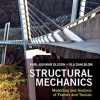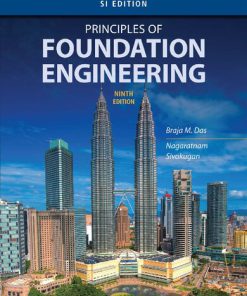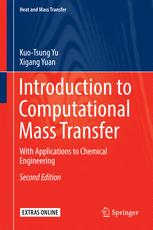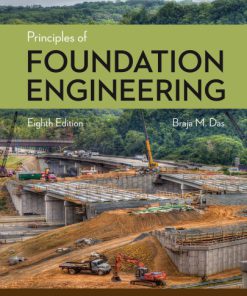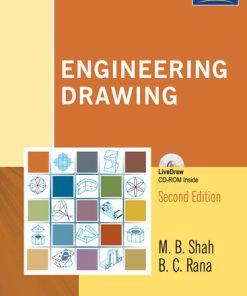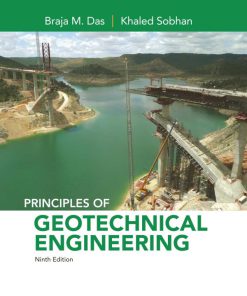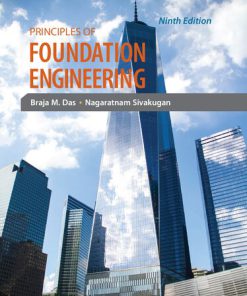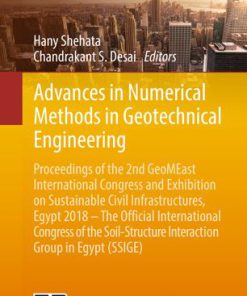Introduction to geotechnical engineering 2nd Edition by Braja M. Das 1305257324 9781305257320
$50.00 Original price was: $50.00.$25.00Current price is: $25.00.
Introduction to geotechnical engineering 2nd Edition by Braja M. Das – Ebook PDF Instant Download/Delivery: 1305257324, 9781305257320
Full download Introduction to geotechnical engineering 2nd Edition after payment
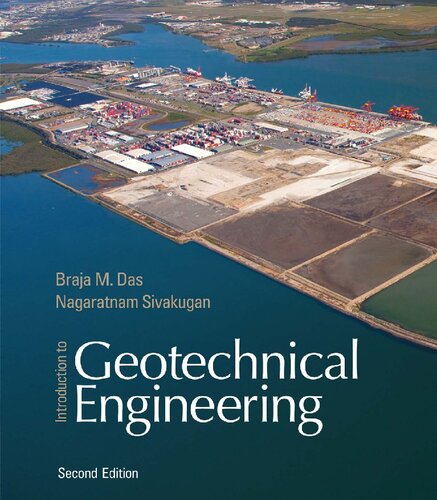
Product details:
ISBN 10: 1305257324
ISBN 13: 9781305257320
Author: Braja M. Das
Written in a concise, easy-to understand manner, INTRODUCTION TO GEOTECHNICAL ENGINEERING, 2e, presents intensive research and observation in the field and lab that have improved the science of foundation design. Now providing both U.S. and SI units, this non-calculus-based book is designed for courses in civil engineering technology programs where soil mechanics and foundation engineering are combined into one course. It is also a useful reference tool for civil engineering practitioners.
Introduction to geotechnical engineering 2nd table of contents:
Chapter 1. Geotechnical Engineering
1.1. Geotechnical Engineering
1.2. Geotechnical Engineering Applications
1.3. Soil Parameters
References
Chapter 2. Grain-Size Analysis
2.1. Introduction
2.2. Soil-Grain Size
2.3. General Soil Deposits
2.4. Some Local Terms for Soils
2.5. Grain-Size Analysis
2.6. Grain-Size Distribution Curve
2.7. Summary
Problems
References
Chapter 3. Weight–Volume Relationships
3.1. Introduction
3.2. Volume Relationships
3.3. Weight Relationships
3.4. Specific Gravity of Soil Solids
3.5. Relationships among Unit Weight, Void Ratio, Moisture Content, and Specific Gravity
3.6. Relationships among Unit Weight, Porosity, and Moisture Content
3.7. Relative Density
3.8. Summary
Problems
References
Chapter 4. Plasticity and Soil Classification
4.1. Introduction
4.2. Consistency of Soil—Atterberg Limits
4.3. Liquid Limit (LL)
4.4. Plastic Limit (PL)
4.5. Shrinkage Limit (SL)
4.6. Engineering Classification of Soil
4.7. AASHTO Classification System
4.8. Unified Soil Classification System
4.9. Summary
Problems
References
Chapter 5. Soil Compaction
5.1. Introduction
5.2. Compaction—General Principles
5.3. Standard Proctor Test
5.4. Factors Affecting Compaction
Effect of Soil Type
Effect of Compaction Effort
5.5. Modified Proctor Test
5.6. Effect of Compaction on Cohesive Soil Properties
5.7. Field Compaction
Compaction Equipment
5.8. Specifications for Field Compaction
5.9. Determination of Field Unit Weight of Compaction
Sand Cone Method (ASTM Designation D-1556)
Rubber Balloon Method (ASTM Designation D-2167)
Nuclear Method
5.10. Summary
Problems
References
Chapter 6. Permeability and Capillarity
6.1. Introduction
6.2. Darcy’s Law
6.3. Hydraulic Conductivity
6.4. Laboratory Determination of Hydraulic Conductivity
Constant-Head Test
Falling-Head Test
6.5. Relationships for Hydraulic Conductivity—Granular Soil
6.6. Relationships for Hydraulic Conductivity—Cohesive Soils
6.7. Permeability Test in the Field by Pumping from Wells
6.8. Capillary Rise in Soils
6.9. Summary
Problems
References
Chapter 7. Stresses in a Soil Mass
7.1. Introduction
7.2. Effective Stress Concept:
7.3. Effective Stress Concept:
7.4. Vertical Stress Increase due to Various Types of Loading:
7.5. Vertical Stress Increase due to Various Types of Loading:
7.6. Vertical Stress Increase due to Various Types of Loading:
7.7. Summary
Problems
References
Chapter 8. Consolidation
8.1. Introduction
8.2. Fundamentals of Consolidation
8.3. One-Dimensional Laboratory Consolidation Test
8.4. Void Ratio–Pressure Plots
8.5. Normally Consolidated and Overconsolidated Clays
8.6. Effect of Disturbance on Void Ratio–Pressure Relationship
8.7. Calculation of Settlement from One-Dimensional Primary Consolidation
8.8. Compression Index ( C c ) and Swell Index ( C s )
8.9. Settlement from Secondary Consolidation
8.10. Time Rate of Consolidation
8.11. Coefficient of Consolidation
Logarithm-of-Time Method
Square-Root-of-Time Method
8.12. Summary
Problems
References
Chapter 9. Shear Strength of Soil
9.1. Introduction
9.2. Mohr-Coulomb Failure Criterion
9.3. Laboratory Determination of Shear Strength Parameters:
9.4. Laboratory Determination of Shear Strength Parameters:
9.5. Laboratory Determination of Shear Strength Parameters:
9.6. Laboratory Determination of Shear Strength Parameters:
9.7. Laboratory Determination of Shear Strength Parameters:
9.8. Laboratory Determination of Shear Strength Parameters:
9.9. Summary
Problems
References
Chapter 10. Subsurface Exploration
10.1. Introduction
10.2. Subsurface Exploration Program
Collection of Preliminary Information
Reconnaissance
Site Investigation
10.3. Exploratory Borings in the Field
10.4. Procedures for Sampling Soil
Split-Spoon Sampling
Scraper Bucket
Thin-Wall Tube
10.5. Observation of Water Levels
10.6. Vane Shear Test
10.7. Cone Penetration Test
10.8. Coring of Rocks
10.9. Preparation of Boring Logs
10.10. Subsoil Exploration Report
10.11. Summary
Problems
References
Chapter 11. Lateral Earth Pressure: At-Rest, Rankine, and Coulomb
11.1. Introduction
11.2. At-Rest, Active, and Passive Pressures
11.3. At-Rest Lateral Earth Pressure:
11.4. At-Rest Lateral Earth Pressure:
11.5. Rankine Earth-Pressure Theory:
11.6. Rankine Earth-Pressure Theory:
11.7. Rankine Earth-Pressure Theory:
11.8. Rankine Earth-Pressure Theory:
11.9. Coulomb’s Earth-Pressure Theory:
11.10. Coulomb’s Earth-Pressure Theory:
11.11. Summary
Problems
References
Chapter 12. Shallow Foundations—Bearing Capacity and Settlement
12.1. Introduction
12.2. Ultimate Bearing Capacity of Shallow Foundations:
12.3. Ultimate Bearing Capacity of Shallow Foundations:
Net Ultimate Bearing Capacity
12.4. Ultimate Bearing Capacity of Shallow Foundations:
12.5. Ultimate Bearing Capacity of Shallow Foundations:
12.6. Ultimate Bearing Capacity of Shallow Foundations:
12.7. Settlement of Shallow Foundations:
12.8. Settlement of Shallow Foundations:
12.9. Settlement of Shallow Foundations:
12.10. Settlement of Shallow Foundations:
12.11. Settlement of Shallow Foundations:
12.12. Settlement of Shallow Foundations:
12.13. Mat Foundations:
12.14. Mat Foundations:
12.15. Mat Foundations:
12.16. Summary
Problems
References
Chapter 13. Deep Foundations
13.1. Introduction
13.2. Pile Foundations:
13.3. Pile Foundations:
Steel Piles
Concrete Piles
Timber Piles
Composite Piles
13.4. Pile Foundations:
Point Bearing Piles
Friction Piles
Compaction Piles
13.5. Pile Foundations:
13.6. Pile Foundations:
13.7. Pile Foundations:
13.8. Pile Foundations:
13.9. Pile Foundations:
13.10. Pile Foundations:
Piles in Sand
Piles in Clay
Piles in Rock
13.11. Pile Foundations:
13.12. Pile Foundations:
13.13. Drilled Shafts:
13.14. Drilled Shafts:
13.15. Drilled Shafts:
Dry Method of Construction
Casing Method of Construction
Wet Method of Construction
13.16. Drilled Shafts:
Drilled Shafts in Sand
Drilled Shafts in Clay
13.17. Drilled Shafts:
13.18. Summary
Problems
References
Chapter 14. Retaining Walls
14.1. Introduction
14.2. Gravity and Cantilever Walls:
14.3. Gravity and Cantilever Walls:
14.4. Gravity and Cantilever Walls:
14.5. Gravity and Cantilever Walls:
14.6. Gravity and Cantilever Walls:
14.7. Gravity and Cantilever Walls:
14.8. Gravity and Cantilever Walls:
14.9. Gravity and Cantilever Walls:
14.10. Summary
Problems
Chapter 15. Slope Stability
15.1. Introduction
15.2. Factor of Safety
15.3. Culmann’s Method for Stability Analysis
15.4. Factor of Safety along a Plane
15.5. Analysis of Slopes with Circular Failure Surfaces—General
Modes of Failure
Types of Stability Analysis Procedures
15.6. Mass Procedures—Slopes in Homogeneous Clay Soil with ϕ = 0
15.7. Mass Procedures—Slopes in Homogeneous c ′ – ϕ ′ Soil
15.8. Ordinary Method of Slices
15.9. Summary
People also search for Introduction to geotechnical engineering 2nd:
an introduction to geotechnical engineering 3rd edition
ahan an introduction to geotechnical engineering 2e
borrow introduction to geotechnical engineering
an introduction to geotechnical engineering 2nd edition
an introduction to geotechnical engineering 2nd edition solutions pdf
Tags: Introduction, geotechnical, engineering, Braja Das
You may also like…
Engineering - Civil & Structural Engineering
Engineering - Chemical Engineering
Medicine
Systems Immunology: An Introduction to Modeling Methods for Scientists 1st Edition Jayajit Das
Engineering - Engineering - General & Miscellaneous
Engineering Drawing 2nd Edition by Shah, Rana ISBN 8131710562 9788131710562
Earth Sciences - Geology
Computers - Programming
Introduction to Software Engineering 2nd Edition Ronald J. Leach



